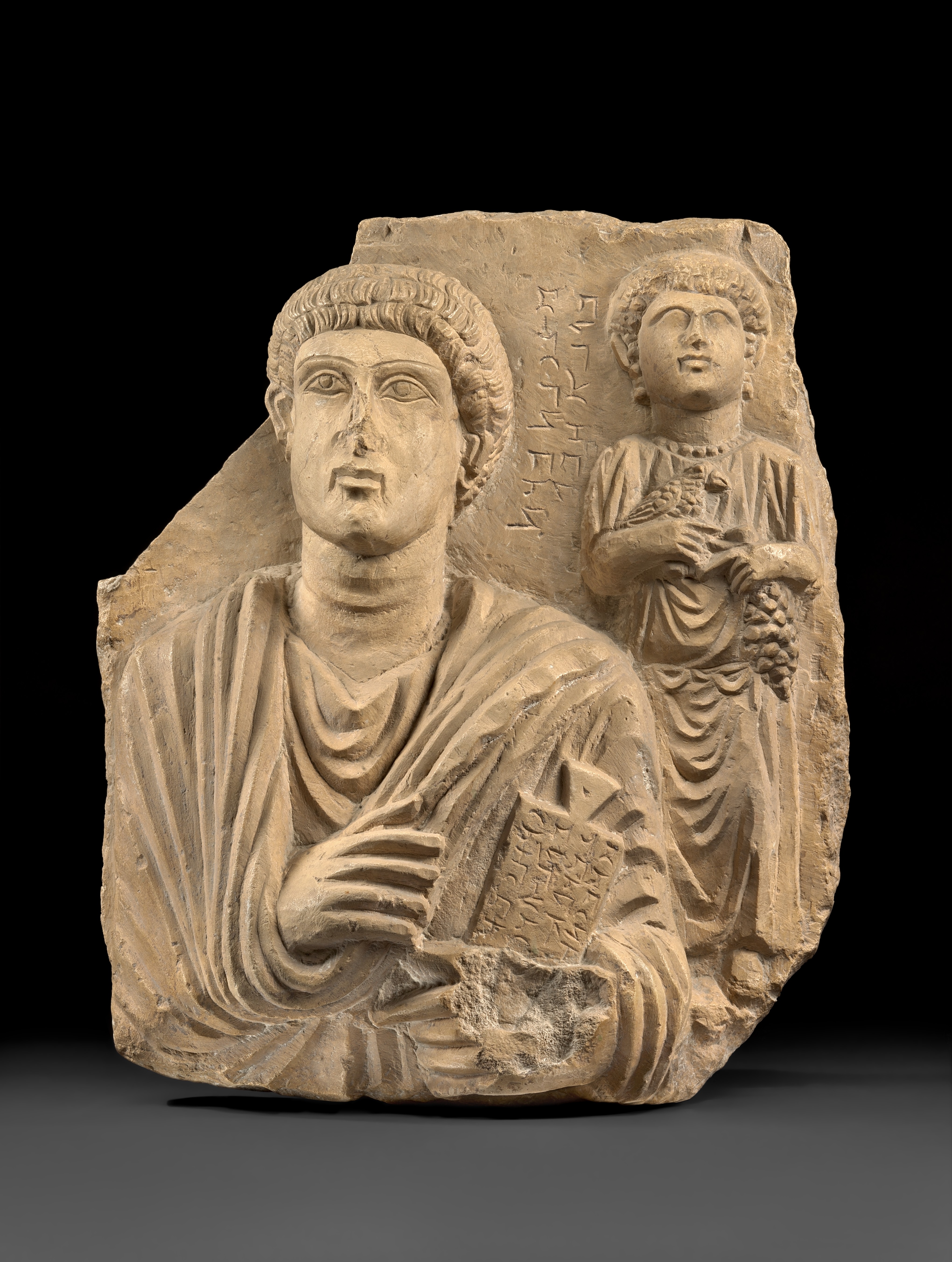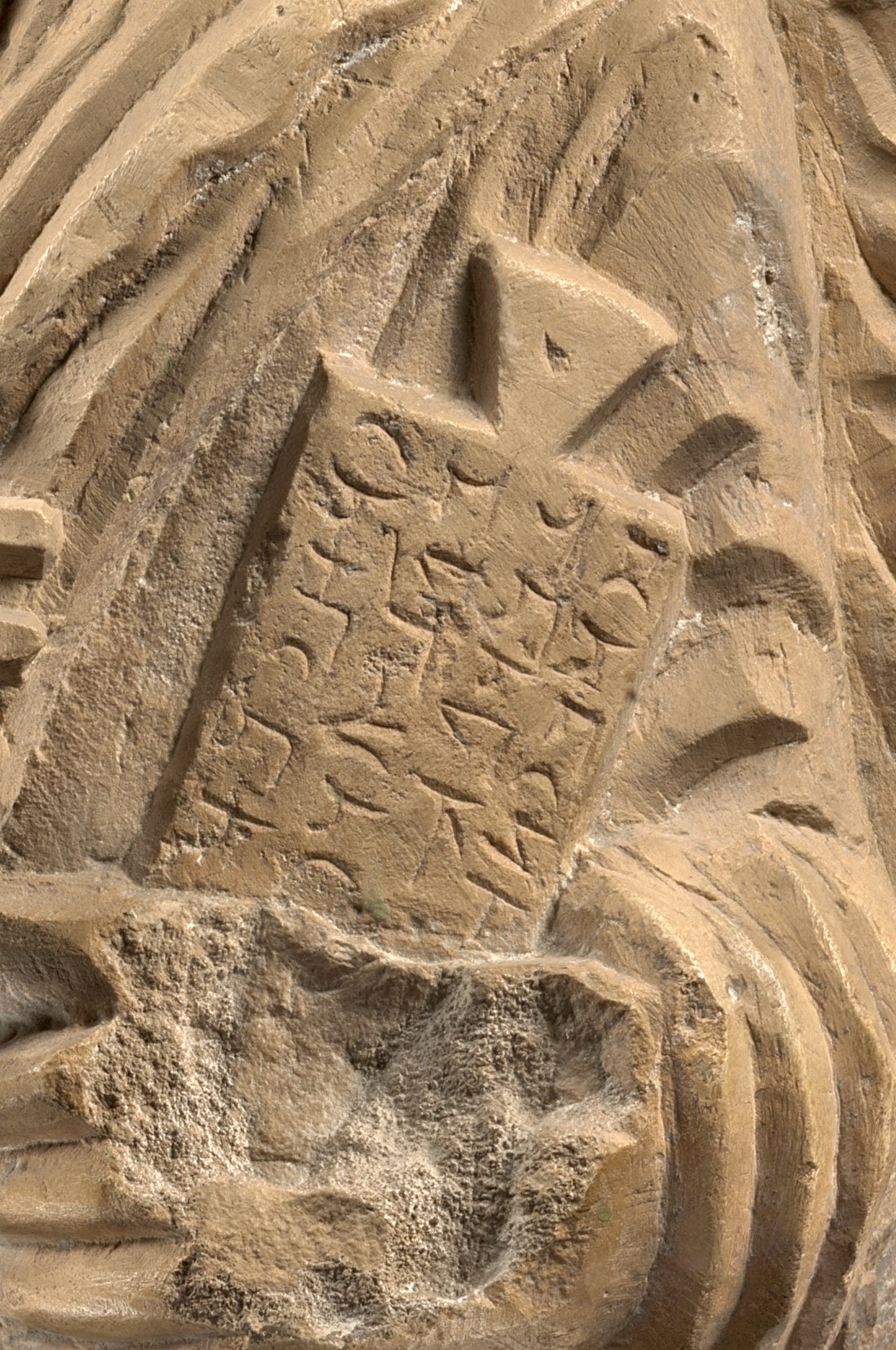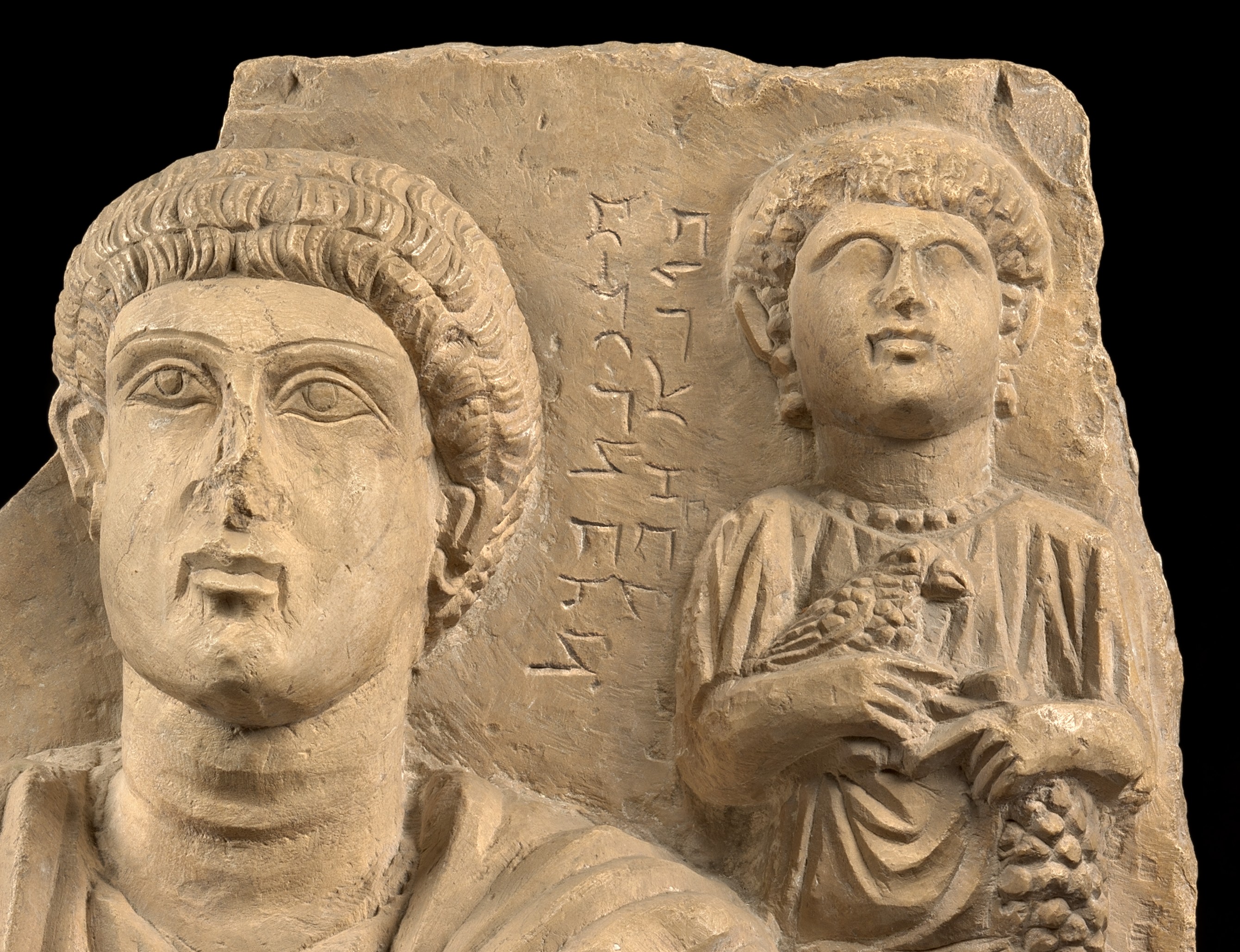The Brother and the Sister, the Tablet, the Epitaph and their Tutor
Unfolding the Story Carved on a Stone Slab from Ancient Tadmor – Palmyra
Łukasz Sokołowski
Under Roman rule, Palmyra grew from a minor caravan station in the middle of the Syrian Desert to an important trade metropolis. About two thousand inscriptions – both private and public – scattered throughout the ruins of the city, allow the ancients to speak for themselves, mostly in their vernacular language, Aramaic, but also in Greek and, occasionally, Latin. Many Palmyrene inscriptions survived inside the numerous tombs, usually engraved as epitaphs above the funerary portraits. One such funerary relief, carefully carved by local stonemasons seventeen centuries ago, shows two prematurely deceased children. What were their names, and what do the accompanying inscriptions reveal about their lives?
A closer look at the relief (Fig. 1), currently displayed in the Museum of Byzantine Art (a division of the Staatliche Museen zu Berlin; inventory number 27/65) shows a text engraved on a yellowish limestone slab measuring approximately 50 × 45 cm; this limestone is typical of the area around Palmyra. The slab was originally rectangular, but both its upper left and lower right corners are now broken off. In Palmyra, such slabs were used to seal the loculi, i.e. rectangular resting ‘slots’ set into the walls of the tombs. The representations on the stone were intended as portraits of the individuals buried there and, according to ancient Syrian beliefs, their souls could remain in these objects for eternity, allowing their relatives to visit them.

On the slab discussed here, the torso of a boy has been carved out together with the smaller figure of a girl behind his left arm. The boy has a chubby face, fashionably arranged hair and wears an ornate cloak. Such a design enables us to date the commission of this relief to somewhere between 235 and 273 CE. The fact that the boy is holding a large tablet with a dovetail handle in his left extended palm (Fig. 2) is very significant. The tablet resembles a tabula ansata (i.e. tablet with handles) widely used in Rome, among other purposes, for transmitting prayers to the gods. However, in this case, the characteristic dovetail handle is shown only at the top edge of the tablet and not on both sides. While one could assume that the boy was shown holding a tabula ansata with one handle hidden in his hand, recent archaeological findings, as well as the available iconographic data, suggest that we are dealing here with a different item directly related to the writing culture of Palmyra. Such a suggestion is supported by the finding of an actual wooden board of identical shape and similar size, inscribed in cursive Palmyrene script in the year 258 CE. This board – well preserved – was found in the Hoq cave on Socotra island in the Indian Ocean, an island which during the third century CE was used for stopovers by Palmyrene merchants.

As with the exemplar from Socotra, the relief found in Berlin shows an inscription carved in the Palmyrene script on the surface of the tablet with a dove-tail handle held by the boy (Fig. 2). The letters, although somewhat clumsy are, nevertheless, clear enough to allow us to know what the inscription says:
YRḤY BR | BWN’ DY | ‛BD LH | MRBYTH
Yarḥai, son of Bônnê to whom it was made by his tutor (also: ‘chief steward’ or ‘legal guardian’ depending on the context)
Here, we see that the front surface of the tablet was used to record an epitaph dedicated to a boy named Yarḥai. After having been carved into the relief by a mason’s chisel, the inscription was most probably later covered with a red or black colour which faded away over the centuries. Indeed, research suggests that the entire relief, including the ‘portraits’, may once have been vividly coloured. The overall composition of intermingling text and surviving images chiselled into the stone look very authentic, even by the high standards of art in Palmyra. The dynamism and eloquence of the scene have been enhanced by the smaller figure of the girl shown from the front, standing behind the boy’s left arm. Interestingly, the facial features of the girl are almost identical to those of the boy, suggesting that the same artisan was at work. Her jewellery – the string of pearls on her neck and her earrings – can be identified as typical feminine attributes in the Palmyrene artistic repertoire. In her right hand, one can recognise a bird, which seems to be a crow, and in the left, a bunch of grapes. Both attributes symbolise the carefree period of early childhood. Moreover, on the slab, just between the figures of the girl and the boy, there is one more Palmyrene inscription, which was possibly chiselled by the hand of the same mason, as is indicated by the identical shape of the letters; they might have been initially coloured too (Fig. 3):
MʻYNT BRT | BWNʼ ḤBL
Maʻinat, daughter of Bônnê. Alas!

This is the standard formula of epitaphs found in Palmyra, this time used for a girl named Maʻinat. Read together with the first text, it suggests that Yarḥai and Maʻinat were most probably siblings, the man named Bônnê being their father. The different sizes of the figures suggest that there could have been a significant age gap between the children: the girl seems to have been much younger than the boy. At the time of her death, Maʻinat was still playing with toys and pet animals, while Yarḥai was old enough to be shown in robes worn by grown-up men and mature teenagers. Moreover, he was also shown with a writing tablet. Evidently, the person who commissioned the relief at a stonemason’s workshop wanted to emphasise the fact that, at the time of his death, the boy was literate. Very probably, the reason for adding the tablet was to show that the boy was not just literate but that he was still being educated.
As already noted, while the tablet might resemble a tabula ansata, which was a common medium for the transmission of epitaphs in mortuary contexts in many parts of the empire, including Palmyra, the study of the local material culture suggests that the object represented is not, stricto sensu, a tabula ansata. Indeed, we have at least two further miniature representations of children from Palmyra who are shown holding small wooden boards with straight bottom edges without the second dovetail handle – a characteristic feature of tabulae ansatae. Thus, the inscribed tablets depicted in the latter were probably not ritual objects, rather they were boards used for writing and shown to suggest that the deceased were literate. Following this interpretation, the depiction of the wooden board in the representation of Yarḥai seems to indicate that the boy’s family enjoyed an elevated status in the Palmyrene community, just as the information in the inscription indicates that the boy was in the care of a tutor. Such portraits were commissioned by the richest Palmyrens, and education with private teachers was an unusual privilege. At that time, children more commonly studied the basics of writing and reading in street schools, provided their parents could afford it. What is more, as we know from the inscription, the dedication to the siblings was made by Yarḥai’s tutor – in Aramaic mrbyth. This word may denote a tutor, a legal guardian, or the chief steward of a large household. In either case, it was a mature individual in charge of the young man, who had possibly lost adult relatives. The tutor was likely also responsible for the education of Yarḥai, which was probably expensive and took place at home.
Unfortunately, much of the story of the two Palmyrene siblings remains unknown to us; however, these two short inscriptions offer some insights into their lives. The depicted tablet itself, together with the inscription written on it, indicates that Yarḥai was probably studying. He may well have been learning the languages known by everyone at a certain level of education and used in everyday life by the local community or by the provincial administration: his native Aramaic, Greek – the lingua franca of the time – and most probably Latin, the language of the distant capital of the Roman Empire. They were all essential to making a career in the society in which his family played a prominent role. Furthermore, if the education aimed to be comprehensive it could be supplemented by other subjects – mathematics being particularly important in handling business and managing the estates. The inscription identifying Maʻinat does not help us understand if she accompanied her brother to classes. There is little evidence concerning female literacy in Palmyra, although there is one other known representation of a girl with a tablet identical to that of Yarḥai.
Although these observations are partly hypothetical, they shed light on literacy in ancient Palmyra, and on the process of education typical of a provincial Roman city located in the Near East. Moreover, they also indicate that a piece of Roman art can serve both as an epigraphic source and as a visual medium carrying a particular message.
References
Brøns, Cecilie, Jens Stenger, Jørn Bredal-Jørgensen, Fabiana Di Gianvincenzo and Luise Ørsted Brandt (2022), ‘Palmyrene Polychromy: Investigations of Funerary Portraits from Palmyra in the Collections of the Ny Carlsberg Glyptotek, Copenhagen’, Heritage, 5/2: 1199‒1239.
Chabot, Jean-Baptiste (1922), Choix d’inscriptions de Palmyre, Paris: Imprimerie Nationale.
CIS = Académie des inscriptions et belles-lettres (1881–1962), Corpus inscriptionum semiticarum, Paris : Parisiis E Reipublicae Typographeo.
Cussini, Eleonora (2022), ‘Palmyrene Cursive and Everyday Writing at Palmyra’, in Michał Gawlikowski and Dagmara Wielgosz-Rondolino (eds), Life in Palmyra, Life for Palmyra: Conference in Memory of Khaled Al-As'ad, Warsaw, April 21st–22nd, 2016, Leuven, Paris, Bristol: Peeters, 99–118.
Krag, Signe, Rubina Raja and Jean-Baptiste Yon (2019), The Collection of Palmyrene Funerary Portraits in the Musei Vaticani: Notes and Observations, with an Introduction by Alessia Amenta, Città del Vaticano: Edizioni Musei Vatican.
Lidzbarski, Mark (1915), Ephemeris für semitische Epigraphik, Vol. III, Giessen: J. Ricker (with Dimitri Andalaft).
Robin, Christian and Maria Gorea (2002), ‘Les vestiges antiques de la grotte de Hôq (Suqutra, Yémen) (note d’information)’, Comptes rendus des séances de l’Académie des Inscriptions et Belles-Lettres, 146/2: 409–445.
Sokołowski, Łukasz (2023), ‘Broadening the View on Literacy in Palmyra: Ten Years after the First Attempt’, in Tibor Grüll (ed.), Representations of Writing Materials on Roman Funerary Monuments: Text, Image, Message, Oxford: Archaeopress, 115–164.
Sokołowski, Łukasz (2014), ‘Portraying Literacy of Palmyra: The Evidence of Funerary Sculpture and their Interpretation’, Etudes et Travaux, 27: 376–403.
Weingarten, Judith (2016), ‘Writing Tablets from Ancient Palmyra (Part II)’: ‘The Forgotten Island entries’ at Zenobia: Empress of the East blog page: <https://roundedglobe.github.io/writing-from-ancient-palmyra-2/>.
Description
Location: Staatliche Museen zu Berlin, Museum für Byzantinische Kunst
Inventory Number: 27/65
Material: limestone
Size: c. 50 × 45 cm
Origin: c. between 235 and 273 CE, Tadmor/Palmyra
Copyright Notice
© Skulpturensammlung und Museum für Byzantinische Kunst, Staatliche Museen zu Berlin – photo: Antje Voigt, 2017
Reference Note
Łukasz Sokołowski, The brother and the sister, the tablet, the epitaph and their tutor: Unfolding the story carved on a stone slab from ancient Tadmor – Palmyra. In Leah Mascia, Thies Staack (eds): Artefact of the Month No. 31, CSMC, Hamburg.
